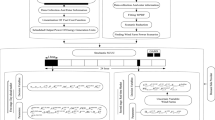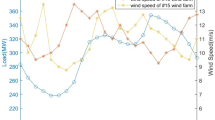Abstract
Recently, the increasing penetration of wind energy has provided various ways to operate the system at low cost and low pollution. On the other hand, the noticeable uncertainties caused by the forecast error of wind speed restrict the utilization of wind energy. Moreover, it brings unprecedented challenges to maintain system adequacy. One prevailing solution is to maintain sufficient spinning reserve of thermal units, which is not affordable. This paper analyses the relationship between the operation cost and wind power uncertainty using AC unit commitment in the frame of a short-term market. Conditional value-at-risk is established in a percentage of the worst-case estimations on wind power scenario under uncertainty to achieve adequate trade-offs between optimal solution and risk aversion. Operation cost of generation, load shedding cost and reserve cost are optimally established by multi-objective optimization. Finally, the simulation is performed on the test system and the obtained results are evaluated and compared to demonstrate the research effectiveness.












Similar content being viewed by others
Abbreviations
- \({{C}}_{{{{i}},t1}}^{{SU}}\) :
-
Start-up cost of unit i in period t1 ($)
- \({\text{C}}_{{{\text{i}},T1}}^{{SD}}\) :
-
Shut-down cost of unit i in period t1 ($)
- \(C_{{iT1}}^{D}\) :
-
Energy cost of unit i in day-ahead market or period t1 ($/MWh)
- \(P_{{{\text{i}}T1}}^{{g\left( D \right)}}\) :
-
Power purchased from unit i in day-ahead market or period t1 (MW)
- \(C_{{{\text{i}}T1}}^{{SR\left( {UP} \right)}}\) :
-
Cost of spinning up reserve by unit i in day-ahead market or period t1 ($/MWh)
- \(R_{{{\text{i}}T1}}^{{SR\left( {UP} \right)}}\) :
-
Spinning up reserve scheduled by unit i in day-ahead market or in period t1 (MW)
- \(C_{{{\text{i}}T1}}^{{SR\left( {DN} \right)}}\) :
-
Cost of spinning down reserve by unit i in day-ahead market or in period t1 ($/MWh)
- \(R_{{iT1}}^{{SR\left( {DN} \right)}}\) :
-
Spinning down reserve scheduled by unit i in day-ahead market or period t1 (MW)
- \(C_{{{\text{i}}T1}}^{{{\text{NSR}}}}\) :
-
Cost of nonspinning reserve by unit i in day-ahead market or period t1 ($/MWh)
- \(R_{{{\text{i}}T1}}^{{{\text{NSR}}}}\) :
-
Nonspinning reserve scheduled by unit i in day-ahead market or period t1 (MW)
- \(C_{{{\text{w}}T1}}^{{\text{D}}}\) :
-
Offer cost of wind producer w in day-ahead market or period t1 ($/MWh)
- \(P_{{{\text{w}}T1}}^{{w\left( D \right)}}\) :
-
Power purchased from wind producer w in day-ahead market or period t1 (MW)
- \(C_{{{\text{j}}T1}}^{{L\left( D \right)}}\) :
-
Energy cost of consumer j in day-ahead market and period t1 ($/MWh)
- \(P_{{{\text{j}}T1}}^{{L\left( D \right)}}\) :
-
Power consumption of consumer j in day-ahead market or period t1 (MW)
- \(P_{{\text{S}}}^{{}}\) :
-
Probability of scenarios S
- \(C_{{{\text{i}}T2,{\text{S}}}}^{{}}\) :
-
Additional costs due to changes in the start-up or shut-down plan of unit i in real-time market or period t2 ($)
- \(r_{{{\text{i}}T2,{\text{S}}}}^{{}}\) :
-
Reserve deployed by unit i in scenarios S and real-time market or period t2 (MW)
- \(C_{{{\text{w}}T2}}^{{spill}}\) :
-
Cost of wind energy spillage from wind producer w in real-time market or period t2
- \(P_{{{\text{w}}T2,{\text{S}}}}^{{w\left( {oe} \right)}}\) :
-
Surplus power spilled of wind producer, compared to the pre-sale power on the day-ahead market in scenarios S and real-time market or period t2 (MW).
- \(C_{{{\text{j}}T2}}^{{{\text{l}}.sh}}\) :
-
Forced outage cost of consumer j in real-time market or period t2 ($).
- \(P_{{{\text{j}}T2,{\text{S}}}}^{{{\text{l}}.sh}}\) :
-
Power not supplied of consumer j in scenarios S and real-time market or period t2 (MW).
- \(b_{{{\text{w}}T2,{\text{S}}}}\) :
-
Binary variable that equals to 1 if wind producer is overproduction during period t2 and 0 otherwise.
- \(r_{{{\text{i}}T2,{\text{S}}}}^{{UP,wind}}\) :
-
Reserve deployed by wind producer in scenarios S and real-time market or period t2 (MW).
- \(r_{{{\text{i}}T2,{\text{S}}}}^{{UP{\text{,g}}}}\) :
-
: Reserve deployed by thermal unit in scenarios S and real-time market or period t2 (MW).
- \(P_{{\text{i}}}^{{{\text{min}}}}\) :
-
Minimum power production of unit i (MW).
- \(P_{{\text{i}}}^{{{\text{max}}}}\) :
-
Maximum power production of unit i (MW).
- \(P_{{\text{j}}}^{{L\left( {min} \right)}}\) :
-
Minimum amount of load j (MW).
- \(P_{{\text{j}}}^{{L\left( {\max } \right)}}\) :
-
Maximum amount of load j (MW).
- \(P_{{\text{w}}}^{{{\text{max}}}}\) :
-
Maximum power production of wind power producer w (MW).
- \(b_{{{\text{i}}T1}}^{{}}\) :
-
Binary Variable that equals to 1 if unit is online during period t1 and 0 otherwise.
- \(Ram_{{\text{i}}}^{UP}\) :
-
Ramp-up rate limit for thermal unit i
- \(Ram_{{\text{i}}}^{DN}\) :
-
Ramp-down rate limit for thermal unit i
- \(C_{{{\text{i}}T2,S}}^{{SU}}\) :
-
Start-up cost of unit i in scenarios S and real-time market or period t2 ($)
- \(C_{{{\text{i}}T2,S}}^{{SD}}\) :
-
Shut-down cost of unit i in scenarios S and real-time market or period t2 ($)
- \(\lambda _{{{\text{i}}T1}}^{{SU}}\) :
-
Start-up fixed cost of unit i in period t1 ($)
- \(S_{{t2S}} \left( {{\text{ni}},{\text{nj}}} \right)\) :
-
Apparent power flow through transmission line from bus ni to nj
- \(Y\left( {{\text{ni}},{\text{nj}}} \right)\) :
-
Admittance value form bus ni to nj
- \(V\left( {nj} \right)\) :
-
Voltage value of bus nj
- \({\text{V}}^{*} \left( {{\text{ni}}} \right)\) :
-
Voltage value of bus ni
- \(N_{{\text{j}}}\) :
-
The total number of consumer
- \(N_{{\text{i}}}\) :
-
The total number of thermal unit
- \(N_{{\text{S}}}\) :
-
The total number of scenarios
- \(N_{{\text{w}}}\) :
-
The total number of wind producer
References
Brooke A, Kendrick D, Meeraus A, Raman R, Rosenthal RE (2004) GAMS: a user’s guide. GAMS Development Corporation, 1998. http://www.gams.com
Doherty R, O’Malley M (2005) A new approach to quantify reserve demand in systems with significant installed wind capacity. IEEE Trans Power Syst 20(2):587–595
Gazafroudi AS, Afshar K, Bigdeli N (2015) Assessing the operating reserves and costs with considering customer choice and wind power uncertainty in pool-based power market. Int J Electr Power Energy Syst 67:202–215
Hirst E (2002) Integrating wind output with bulk power operations and wholesale electricity markets. Wind Energy 5(1):19–36
Holttinen H, Söder L, Ela E (2009) Design and operation of power systems with large amounts of wind power: final report, IEA WIND Task 25, Phase one 2006–2008. VTT Technical Research Centre of Finland
Hosseini-Firouz M (2013) Optimal offering strategy considering the risk management for wind power producers in electricity market. Electr Power Energy Syst 49:359–368
Johnson G (2008) Renewable energy and Tesla coil page. http://eece.ksu.edu/~gjohnson/. Accessed 5 Feb 2008
Karapidakis ES, Hatziargyriou ND (2002) Online preventive dynamic security of isolated power systems using decision trees. IEEE Trans Power Syst 17(2):297–304
Laia R, Pousinho HMI, Melicio R, Mendes VMF (2016) Bidding strategy of wind-thermal energy producers. Renew Energy 99:673–681
Li Y, Dong Y, Wu X, Yuan S, Xu Z, Shen T (2019) Scenario-based unit commitment model considering stochastic wind power. In: 2019 IEEE 3rd conference on energy internet and energy system integration (EI2). IEEE, pp 1917–1921
Liu W, Lund H, Mathiesen BV (2011) Large-scale integration of wind power into the existing Chinese energy system. Energy 36(8):4753–4760
Minitab LLC (2013) Minitab. http://www.minitab.com
Morales JM, Conejo AJ, P’erez-Ruiz J (2010) Short-term trading for a wind power producer. IEEE Trans Power Syst 25(1):554–564
Mousavi-Taghiabadi SM, Sedighizadeh M, Zangiabadi M, Fini AS (2020) Integration of wind generation uncertainties into frequency dynamic constrained unit commitment considering reserve and plug in electric vehicles. J Cleaner Prod 276:124272
Papadogiannis KA, Hatziargyriou ND (2004) Optimal allocation of primary reserve services in energy markets. IEEE Trans Power Syst 19(1):652–659
Park H, Jin YG, Park JK (2018) Stochastic security-constrained unit commitment with wind power generation based on dynamic line rating. Int J Electric Power Energy Syst 102:211–222
Ramandi MY, Afshar K, Gazafroudi AS, Bigdeli N (2016) Reliability and economic evaluation of demand side management programming in wind integrated power systems. Int J Electr Power Energy Syst 78:258–268
Reddy SS, Abhyankar AR, Bijwe PR (2012) Market clearing for a wind-thermal power system incorporating wind generation and load forecast uncertainties. In: 2012 IEEE power and energy society general meeting. IEEE, pp 1–8
Reddy SS, Panigrahi BK, Kundu R, Mukherjee R, Debchoudhury S (2013a) Energy and spinning reserve scheduling for a wind-thermal power system using CMA-ES with mean learning technique. Int J Electr Power Energy Syst 53:113–122
Reddy SS, Bijwe P, Abhyankar A (2013b) Multi-objective market clearing of electrical energy, spinning reserves and emission for wind-thermal power system. Int J Electr Power Energy Syst 53:782–794
Reddy SS, Bijwe P, Abhyankar A (2015) Optimum day-ahead clearing of energy and reserve markets with wind power generation using anticipated real-time adjustment costs. Int J Electr Power Energy Syst 71:242–253
Schlueter RA, Park GL, Lotfalian M, Shayanfar H, Dorsey J (1983) Modification of power system operation for significant wind generation penetration. IEEE Trans Power App Syst 102(1):153–161
Siahkali H, Mokhtari MR, and Ahmadi F (2010) Fuzzy modeling of wind power and pumped storage outputs in operation planning of restructured power system. In: 25th international power system conference (PSC), Iran
Sun Y, Dong J, Ding L (2017) Optimal day-ahead wind-thermal unit commitment considering statistical and predicted features of wind speeds. Energy Convers Manage 142:347–356
Wu YK et al (2019) Unit commitment in a high wind-power penetration system. Energy Procedia 156:18–22
Zhang Y, Giannakis GB (2015) Distributed Stochastic Market Clearing With High-Penetration Wind Power. IEEE Trans Power Syst 31(2):895–906
Zhang N, Kang C, Xia Q, Ding Y, Huang Y, Sun R, Bai J (2014) A Convex Model of Risk-Based Unit Commitment for Day-Ahead Market Clearing Considering Wind Power Uncertainty. IEEE Trans Power Syst 30(3):1582–1592
Author information
Authors and Affiliations
Corresponding author
Rights and permissions
About this article
Cite this article
Hosseini-Firouz, M., Alemi, A., Alefy, B. et al. Unit Commitment Model under Uncertainty of Wind Power Producer. Iran J Sci Technol Trans Electr Eng 45, 1295–1309 (2021). https://doi.org/10.1007/s40998-021-00429-6
Received:
Accepted:
Published:
Issue Date:
DOI: https://doi.org/10.1007/s40998-021-00429-6




